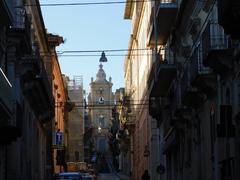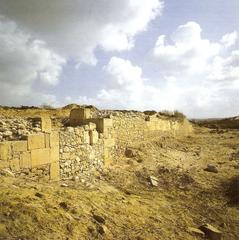Museo Del Duomo Ragusa: Visiting Hours, Tickets, and In-Depth Guide to Ragusa Historical Sites
Date: 14/06/2025
Introduction
Nestled in the heart of Ragusa Ibla, Sicily, the Museo del Duomo di San Giorgio stands as a testament to the city’s enduring religious, artistic, and architectural legacy. Adjoining the iconic Duomo di San Giorgio—a masterpiece of Sicilian Baroque—this museum offers visitors a captivating journey through centuries of sacred art and ecclesiastical history. The museum’s carefully curated collections, set within the atmospheric canonical quarters, illuminate Ragusa’s transformation from its ancient origins, through the devastation and rebirth following the 1693 earthquake, to its status as a UNESCO World Heritage Site. Whether you are an avid art lover, a history enthusiast, or a cultural traveler, the Museo del Duomo promises an unforgettable encounter with one of Sicily’s most treasured landmarks (theworldofsicily.com; enjoysicilia.it).
Historical Context: From Antiquity to Baroque Splendor
Ragusa’s roots stretch back to the Sicels, Sicily’s indigenous people, and the city has absorbed influences from Greek, Roman, Byzantine, Arab, Norman, and Spanish rule. The catastrophic 1693 earthquake destroyed much of the region, including Ragusa’s medieval fabric. In the aftermath, Ragusa was rebuilt in two centers: Ragusa Superiore and Ragusa Ibla. This period marked the rise of Sicilian Baroque, with the Duomo di San Giorgio as its crown jewel, symbolizing the city’s resilience and artistic renaissance.
The Duomo di San Giorgio: Architectural and Cultural Significance
Origins and Baroque Mastery
The original Church of San Giorgio was destroyed in the 1693 earthquake. Intense civic rivalry over the location of the new cathedral led, in 1738, to the commissioning of architect Rosario Gagliardi. The resulting Duomo di San Giorgio (1738–1775, with the dome completed in 1820) is celebrated for its dramatic Baroque facade, ascending three tiers in a “tower” configuration, richly adorned with statues, volutes, and a soaring neoclassical dome that dominates Ragusa Ibla’s skyline (Italia.it; SpottingHistory).
Inside, the cathedral features a luminous nave decorated with elaborate stuccos, gold accents, and frescoes depicting scenes from the life of St. George. Artistic masterpieces by D’Anna, Tresca, and Manno further enrich the spiritual atmosphere (TheGoGuy).
The Duomo is also a cultural icon, frequently featured in popular media, most notably the TV series “Il Commissario Montalbano,” which has brought international attention to Ragusa’s Baroque splendor.
Museo del Duomo di San Giorgio: Foundation and Collections
Origins and Development
The Museo del Duomo, inaugurated in 2009, was established to preserve and showcase the religious and artistic heritage associated with the cathedral and the city’s ecclesiastical traditions (theworldofsicily.com). Housed in the historic canonical quarters beside the Duomo, the museum’s architecture itself tells a story, with preserved arches and masonry echoing centuries of adaptation (enjoysicilia.it).
Highlights of the Permanent Collection
- Fragments from the Pre-1693 Church: Stone and decorative remnants from the original late-Gothic structure, offering a tangible link to Ragusa’s earlier religious landscape.
- Byzantine Enkolpion: A rare pectoral cross containing relics of Saints Peter and Paul, exemplifying early Christian influences.
- Processional Crosses and Silverware: Including a 16th-century processional cross by Lucio Arizzi and exquisite silver and copper liturgical objects reflecting Sicilian craftsmanship.
- Ostensorio d’Oro: An 18th-century gold monstrance by Giuseppe Vella, adorned with diamonds, emeralds, and rubies, representing the height of Palermo goldsmith artistry (theworldofsicily.com).
- Paintings and Portraits: Works by local artists such as Matteo Battaglia, including devotional images of St. George and portraits of historic clergy.
- Liturgical Vestments and Paramenti: Embroidered vestments and ceremonial objects documenting the grandeur of Ragusa’s religious processions.
- Original Architectural Drawings: Plans by Rosario Gagliardi, offering rare insight into the cathedral’s design and the challenges of Baroque reconstruction (Italy Heaven).
The museum’s “Tesoro di San Giorgio” treasury is a particular highlight, featuring reliquaries, chalices, and sacred vessels that reflect centuries of devotion (Museionline).
Museum Layout and Visitor Experience
The museum’s layout guides visitors through thematic rooms, each narrating aspects of Ragusa’s religious and civic evolution. Informative displays are available in multiple languages, and the manageable size of the collection allows for focused and rewarding exploration (WhichMuseum).
Visitor Information: Hours, Tickets, and Accessibility
- Location: Adjacent to Duomo di San Giorgio, Ragusa Ibla.
- GPS Coordinates: 36.92642, 14.74215 (ecomuseocarat.it).
- Contact: Tel. 0932/654113; reservations +39 392 0797486.
Opening Hours
- Cathedral: Open daily, typically 9:00–19:00.
- Museum: Most commonly open weekends (Saturday and Sunday 9:30–18:00), with extended daily hours in summer (10:00–12:30). Visits outside these times can often be arranged by appointment (Museionline; WhichMuseum; ecomuseocarat.it).
- Note: Hours may vary seasonally and during religious festivals—always confirm before your visit.
Tickets and Admission
- Cathedral: Free entry (donations welcome).
- Museum: Admission €3–5; combined tickets with the cathedral campanile (for panoramic views) are available.
- Purchasing: Tickets can be bought onsite or reserved by phone; advance booking is recommended during peak seasons.
Accessibility
- The museum’s historic setting means some areas may present challenges for visitors with limited mobility. It is advisable to contact the museum in advance for assistance. Clear signage and a compact layout help accommodate most visitors.
Travel Tips for Visiting Museo del Duomo di San Giorgio
- Reserve in Advance: Especially during summer and festival periods.
- Combine Visits: Explore both the museum and Duomo for a comprehensive cultural experience.
- Photography: Non-flash photography is permitted in most areas—check with staff onsite.
- Best Time to Visit: Early mornings or weekdays for a quieter experience.
- Getting There: The museum is centrally located in Ragusa Ibla and easily reached on foot from the historic center. Public buses serve nearby stops; if driving, use designated parking to preserve the pedestrian-friendly environment.
Events, Guided Tours, and Educational Programs
- Guided Tours: Offered periodically and during special events, providing expert insight into the collections and cathedral architecture (Museionline).
- Special Events: The museum participates in local cultural festivals, notably the annual feast of St. George, which features processions, music, and special exhibitions.
- Educational Resources: Informational panels and multilingual materials are available, making the museum accessible to international visitors.
Nearby Attractions and Exploring Ragusa Ibla
After your museum visit, discover more of Ragusa Ibla’s rich heritage:
- Duomo di San Giorgio: Ascend the monumental staircase for panoramic city views.
- Gothic Portal of San Giorgio Vecchio: A rare remnant of the original pre-Baroque church (The Road Reel).
- Giardino Ibleo: A tranquil park with scenic vistas.
- Palazzo Arezzo di Trifiletti and Circolo di Conversazione: Exemplars of Baroque civic architecture.
- Local Cafés and Piazza Duomo: Enjoy Sicilian cuisine and vibrant street life.
Ragusa Ibla’s pedestrian-friendly layout and stunning Baroque architecture make it an ideal area for leisurely exploration (Italia.it; PlanetWare).
Frequently Asked Questions (FAQ)
Q: What are the Museo del Duomo di San Giorgio opening hours?
A: Generally open weekends 9:30–18:00, with extended summer hours and visits by appointment.
Q: How much do tickets cost?
A: Museum admission is usually €3–5; combined tickets with the cathedral campanile are available.
Q: Is the museum wheelchair accessible?
A: Some areas may be challenging due to historic architecture; contact the museum for further information.
Q: Are guided tours available?
A: Yes, tours are offered during special events and by appointment.
Q: Can I take photos inside?
A: Photography is allowed in most areas, but flash and tripods may be restricted.
Visuals and Media Recommendations
To enhance your visit, browse high-quality images of the museum’s interiors, key artifacts like the Ostensorio d’Oro, and maps of Ragusa Ibla highlighting the museum’s location. Virtual tours and video walkthroughs are available on various tourism portals. For an immersive digital experience, ensure images include descriptive alt tags (e.g., “Duomo di San Giorgio façade Ragusa”) to improve accessibility and SEO.
Conclusion: Experience Ragusa’s Timeless Beauty
The Museo del Duomo di San Giorgio, together with the adjacent cathedral, offers a profound glimpse into Ragusa’s spiritual and artistic legacy. From ancient artifacts and Byzantine reliquaries to the grandeur of Sicilian Baroque, the museum narrates a story of faith, resilience, and creativity. Practical visitor information—clear hours, affordable tickets, and accessible guided tours—ensures every traveler can tailor their experience. The museum’s central location encourages further exploration of Ragusa Ibla’s Baroque treasures, scenic viewpoints, and lively piazzas.
To make the most of your journey, download the Audiala app for up-to-date visitor information, digital tours, and exclusive content on Ragusa’s historical sites.
References
- Visiting the Duomo di San Giorgio in Ragusa: History, Tickets, and Travel Tips (theworldofsicily.com)
- Museo del Duomo Ragusa: Visiting Hours, Tickets, and History of Ragusa’s Iconic Cathedral Museum (enjoysicilia.it)
- Architectural and Artistic Significance (Italia.it)
- Museo del Duomo di San Giorgio Visiting Hours, Tickets, and Highlights in Ragusa (Museionline)
- Opening times and practical info (ecomuseocarat.it)
- Ragusa Baroque, travel guides and museum highlights (WhichMuseum; Italy Heaven; TheGoGuy; SpottingHistory; PlanetWare; The Road Reel; Along Dusty Roads)

